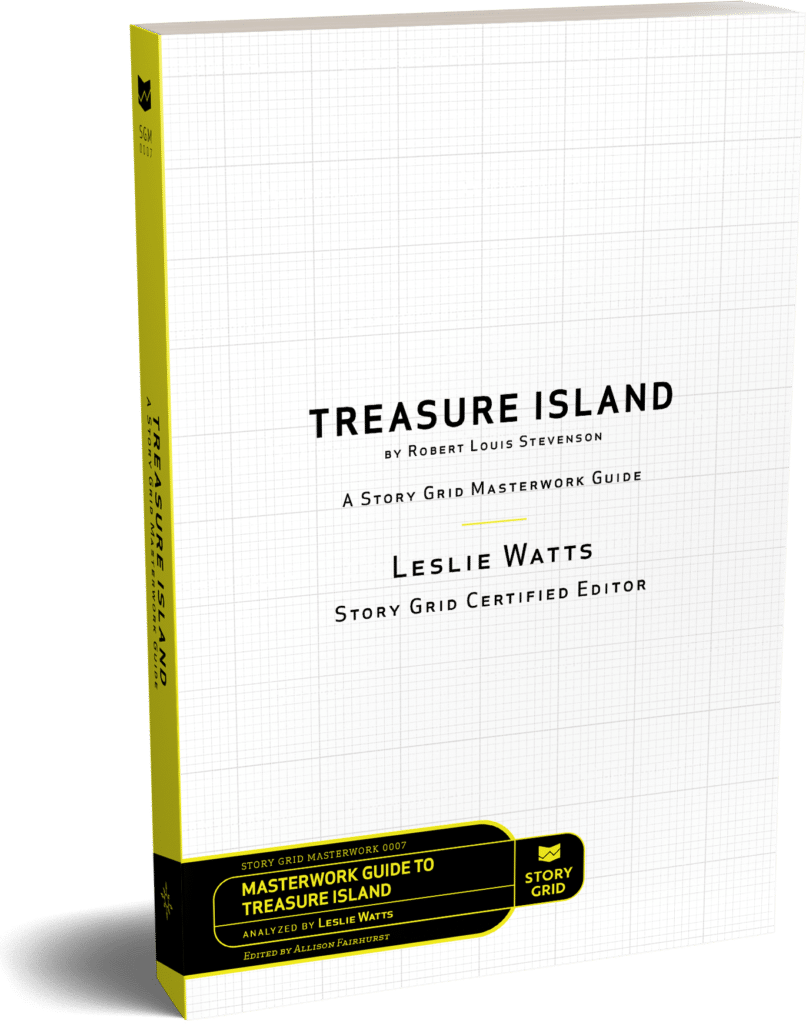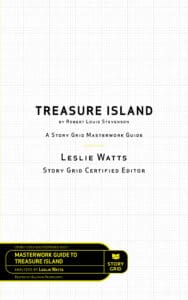Treasure Island by Robert Louis Stevenson: A Story Grid Masterwork Analysis Guide
Written by Leslie WattsEdited by Allison Fairhurst
Open Treasure Island, and you expect to find a thrilling adventure tale of pirates, shipwrecks, and lost booty. But if you join Story Grid writer and editor Leslie Watts in analyzing Robert Louis Stevenson’s classic novel, you’ll also discover timeless lessons about the craft of storytelling.
First published in 1883, Treasure Island offers readers irresistible life-or-death stakes and a compelling coming-of-age arc for young hero Jim Hawkins. And, of course, Stevenson introduces the cunning Long John Silver, one of literature’s most unforgettable shapeshifting antagonists, complete with wooden leg and parrot.
Watts turns the novel itself into a treasure map, following “landmarks of change” to discover how the author fulfills readers’ expectations on multiple levels as the characters adapt to an imperfect, often terrifying world. “The way Jim outwits Silver and the other pirates is a useful lesson for life and writing,” says Watts.
If you’re a writer who is serious about your craft, there’s no better way to learn to capture, entertain, and enlighten readers than by exploring a masterwork. In this Guide, Leslie Watts shares her map, so climb aboard and let’s set sail.

Purchasing Options
ALSO AVAILABLE
Treasure Island by Robert Louis Stevenson was published in November of 1883 after being serialized the previous two years in a magazine.
That makes the novel over 137 years old!
So why would Story Grid Publishing Editor-in-Chief Leslie Watts take the extensive time and energy involved in writing our newest book Treasure Island by Robert Louis Stevenson: A Story Grid Masterwork Analysis Guide?
Why not pick a more contemporary work of fiction?
What benefits come from studying old stories?
FIRST, old stories are proven crowd pleasers. People keep buying them. Treasure Island is still selling on Amazon. This means the book has gone far beyond a momentary sensation and continues to speak to people.
I think we all hope our work is still being read in 100 years!
SECOND, we often miss important aspects of the story because we’re too familiar with it. Old stories help us see story components that may be invisible to us in contemporary stories. We can’t see the air we breathe.
THIRD, old stories allow us to see beyond our current setting, language, and culture. It’s similar to traveling to a different place or studying a foreign language and seeing how the same things are done differently.
FOURTH, old stories make analysis easier. Old stories make it easier to see and think of genre conventions in the abstract, which is really useful for writing stories.
The Shadow Agent of Treasure Island
As you go through our Masterwork Guide to Treasure Island, you’ll notice the Shadow Agent (or villain) of the story — Long John Silver — is a great model to study.
Even though most of what we think of as “pirates” comes from Treasure Island, Long John Silver does not play the role of a conventional pirate.
Looking through the Heroic Journey 2.0 lens, Long John Silver isn’t just the Shadow Agent.
Long John Silver is also the Shapeshifter of the story.
What can we learn from Treasure Island about developing a Shadow Agent that also plays the role of a Shapeshifter in our stories?
- They use code switching — changing their behavior, speech, etc around different individuals or groups of people — to get what they want.
- They are fluid, hard to pin down.
- They are patient.
- They blend in and are “snakes in the grass.” They are dangerous because we can’t see them for who/what they are.
- However, they see us and pay attention. They know where we are vulnerable. They have no problem exploiting that knowledge. This makes Long John Silver more dangerous than the indifferent pirates interested only in consumption.
- They have way more experience than the people they exploit. They’ve probably been exploited and have learned from it.
- They are the bad boyfriend/girlfriend, the manipulative friend, or the slick politician/lawyer.
- It feels like you are on the same team, but they are in it for themselves.
When I’ve approached my villains, I often get stuck thinking of them one-dimensionally.
However, looking closely at Long John Silver in Treasure Island by Robert Louis Stevenson: A Story Grid Masterwork Analysis Guide help expand my thinking on the approach I can take with my own Shadow Agents.
Going Back to the Origins
While Treasure Island isn’t the first book to feature sea voyages, pirates or a young person coming of age, we can trace much of what is embedded in our modern culture about all three back to this book from 1883.
By following these conventions and tropes back to their origin, it helps us see what we are trying to accomplish.
We can see the function instead of just the features.
We can see what the author is trying to accomplish with these conventions.
For instance, let’s look at the pirates in Treasure Island.
- They tend to look weathered.
- They bear scars and are sometimes missing an eye or limb.
- They are tough and strong.
- They have parrots and other trappings of the faraway places they’ve visited.
- They are unpredictable.
- They tell stories, sing songs, drink a lot, fight a lot.
- Most of all, pirates are forces of chaos.
All of these traits make them seem worldly and strong. They live life outside the rules of society and that makes them interesting/attractive. But they are dangerous.
If any of these traits were missing, we would feel something off about the pirates.
However, they are not the main villain (or Shadow Agent) of Treasure Island (that title goes to Long John Silver).
Robert Louis Stevenson uses the pirates to throw a wrench in the plans of the main characters.
Whenever the story might get boring, lo and behold, the pirates show up!
When I think of pirates from this functional stand point, other types of unpredictable chaos comes to mind…
- Zombies
- Tornados, hurricanes, earthquakes
- Terrorists
- Ex-boyfriends/girlfriends/spouses
When we push back from the story and look at the function the pirates in Treasure Island are performing, it can help us see what is missing from our own stories.
What forces of unpredictable chaos can we drop into our story?
This is what we get when we go back to origin stories.
It’s easier to push back from the story and see the function of the characters, settings, etc instead of getting caught up in what is happening on the page.

Leslie Watts is a certified Story Grid editor, writer, and podcaster. She’s been writing for as long as she can remember: from her sixth-grade magazine about cats to writing practice while drafting opinions for an appellate court judge.
When the dust settled after her children were born, she launched Writership.com to help writers unearth the treasure in their manuscripts. She believes writers become better storytellers through practice, and that editors owe a duty of care to help writers with specific and supportive guidance to meet reader expectations and express their unique gifts in the world.

Allison Fairhurst is a fiction writer, a book coach, and a story nerd though and through. She studied Literature and Creative Writing at University. After graduating in 2012, she continued on her path to learn the craft of writing and editing through workshops, masterclasses, many books, and of course, Story Grid. Though building her print record, she was last published on Lemonhound.com, in Bone Bouquet 5.1, and in Dirt Magazine. Connect with her at allisonfairhurst.com.
